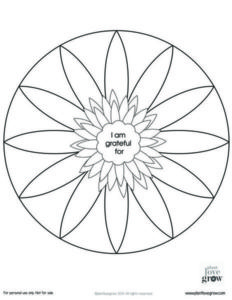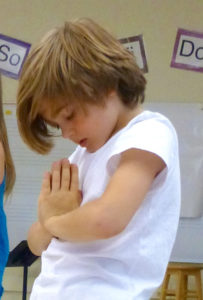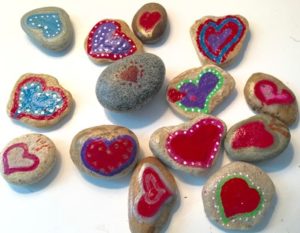We can only be said to be alive in those moments when our hearts are conscious of our treasures. Thornton Wilder
2017, a new year, and I am realizing again how full my heart is and how much I am grateful for. The New Year is often a time to make resolutions, or set intentions. An intention can be something you would like to bring into your life, like positive energy such as gratitude, forgiveness, or patience. In yoga, we often set an intention at the beginning of class as a focus for our practice as well as in our life.
My intention as we begin 2017 is to explore and share gratitude in my personal life and in my children’s yoga classes.
Research has shown that a sense of gratitude, or feeling thankful and appreciative of the good things in one’s life can increase happiness and improve health. Practicing gratitude inspires more joy and optimism, and significantly increases well-being and life satisfaction.
While I am on the science of Gratitude, I would like to share this article that outlines the wonderful benefits of expressing gratitude, by Psychotherapist, Amy Morin.
7 Scientifically Proven Benefits of Gratitude
- gratitude opens the door to more relationships
- gratitude improves physical health. Grateful people feel better and are more likely to take care of their health
- gratitude improves psychological health. Effectively increases happiness and reduces depression
- enhances empathy and reduces aggression. More likely to behave in socially appropriate manner
- sleep better. Journaling before bed
- improves self-esteem. Reduces social comparisons
- increases mental strength. Reduces stress, plays a major role in overcoming trauma
So, how to integrate gratitude into children’s yoga classes and into family activities at home?
Many of my yoga classes begin with setting an intention, a way to practice gratitude. I discuss the idea of dedicating their yoga practice to someone else. The younger yogis like to draw a picture of that person or beloved pet and place it at the top of their mat to help them stay focused.
My Gratitude Sequence
- Balloon Breath with the hands pinky sides together as if holding the world in your hands.
2. Gratitude Ball. A ball is passed around a circle to each yogi. Whoever has the ball says something they are grateful for.
3. Active “Thankful” Yoga Sequence:
- Thankful for the Sun: Sun Salutations to music: Dance for the Sun by Kira Willey (4-6 yr. olds), Here Comes the Sun with Yo Yo Ma (Sun Salutation B)
- Thankful for the breeze: standing in Mountain Pose (Tadasana), release arms to side. Twist from side-to-side letting the arms swing, as though they were blowing in the wind.
- Thankful for the Rain: From Mountain Pose inhale arms up to the sky, as if grabbing the clouds, giving thanks to the rain. Exhale with hands to the floor, like a raindrop falling to the ground
- Thankful for the Flowers and Trees: From Mountain Pose and draw the sole of one foot either above or below the knee to practice Tree Pose on both sides. Hands can be by the sides, at heart center or raised overhead.
- Thankful for Our Friends: Partner poses are a great way to have fun with our friends. 2 favorites are Lizard on a Rock and Double Boat!
- Thankful for Our Families: Group version of Warrior III. Standing in a circle, yogis put their arms around each other. As a family, everyone lifts up the right leg and leans forward, reaching with the crown of the head. In this group pose yogis can physically feel the support of their family. Repeat on the other side.
- Thankful for Ourselves: Hug ourselves
- Thankful for the Animals on Earth and Fish in the Sea: do poses in sequence: Butterfly, Turtle, Fish, Swan, Cat, Cow, Dog, Dolphin, Rabbit, Elephant, Horse, Giraffe
- Thankful for Mother Earth: Child’s Pose
Piglet noticed that even though he had a Very Small Heart, it could hold a rather large amount of Gratitude
A.A. Milne
There are many wonderful books for all ages regarding gratitude. I incorporate literacy into many of my yoga classes. A few on gratitude:
Gratitude is a Funny Thing by Kathy Walsh, for preschoolers.
The Quiltmaker’s Gift by Jeff Brumbeau, for grades 1-4.
The Table Where Rich People Sit by Bryd Baylor, for ages 7-10.
There is a Flower at the Tip of My Nose Smelling Me by Alice Walker, for grades 2-5. This is one of my favorites as it celebrates the beauty of the world and our connection to it. Ms. Walker’s series of short verses are packed with emotion and joyfulness!
(I’ve listed more books on Gratitude at the end of this blog)
There are many simple activities I incorporate into yoga classes for children that can gently remind them what they are grateful for. These activities can easily be done at home.
- Gratitude Jar: have each child bring in a washed out jar with top (spaghetti sauce size). They can decorate it (ribbon, stickers, sequins, etc.) and in every yoga class they will have time to write something they are grateful for on a strip of paper and place it in their jar. The last yoga
 class of the series, each child takes a strip out of their jar and shares with the class, then takes their jar home to share with their family.
class of the series, each child takes a strip out of their jar and shares with the class, then takes their jar home to share with their family. - Gratitude Mandala: Find a Mandala with an open center to color. Write an intention, a focus for your practice as well as your life, in the center of the mandala. This can represent a value you’d like to bring into your life. Something to reflect on as we go into the New Year.
- I ask the littlest yogis to “draw what makes you happy” then to share with the group. Preschoolers and Kindergarteners especially love to color, inspiring creativity and confidence.
- Thank You Notes: A fun and meaningful craft I include in my yoga classes, especially around Thanksgiving and Valentine’s Day, is creating and writing notes of gratitude. Using colorful, patterned square paper, we follow the video to make beautiful envelopes https://www.facebook.com/5min.crafts/videos/825945917547995/ The kids then write their notes on the inside of the envelope and give them to friends or family members.
- In yoga classes for ‘Tweens and Teens they make and keep Gratitude Journals. Each yogi designs their own journal, using any materials they wish, like scrap booking. Their journals are kept with their yoga mats, so go home with them and return to class. They share something from their journal in each yoga class.
- Gratitude Stones, physical reminders of all that you are grateful for. I like to paint hearts of all shapes and sizes
 on small and medium sized stones to remind myself what “makes my heart happy”. The children like to paint what they are thankful for: many animals, flora and fauna. We paint extras to share with friends and family. (Refer to my blog on painted stones for directions on how to paint stones)
on small and medium sized stones to remind myself what “makes my heart happy”. The children like to paint what they are thankful for: many animals, flora and fauna. We paint extras to share with friends and family. (Refer to my blog on painted stones for directions on how to paint stones)
So, what are you grateful for today? How will you integrate gratitude into your life? What can you do daily to express gratitude to those around you or friends and loved ones from afar? Set your intentions for the New Year for more joy, optimism and better health.
As we express our gratitude, we must never forget that the highest appreciation is not to utter words but to live by them.
John F. Kennedy

More Children’s Books about Gratitude with recommended ages, although most of these books will be enjoyed by ages 3-11 and their caregivers.
Let’s Be Thankful by P.K. Hallinan, Preschool
The Blue Daisy: A Lesson in Gratitude by Stacie Theis, Preschool
Feeling Thankful by Shelly Rotner, Preschool-K
An Awesome Book of Thanks by Dallas Clayton, ages 4-7 (quirky and whimsical)
Did I Ever Tell You How Lucky You Are by Dr. Seuss, Preschool-Gr. 4
Just So Thankful by Mercer Myer, Preschool-Gr. 2
Thanks a Million by Nikki Grimes, Gr. 1-5. Poems of being thankful, haikus, rebus, riddles.
Those Shoes by Maribeth Boeltz, Preschool-Gr.3
The Secret of Saying Thanks by Douglas Wood, Preschool-Gr.3.


Leave a Reply